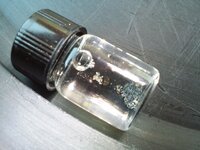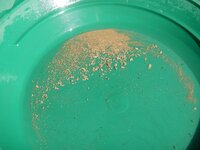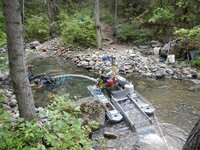CO2
Jr. Member
- Sep 20, 2015
- 71
- 95
- Detector(s) used
- 12' corrugated plastic drainpipe, BGT Pro. 30
- Primary Interest:
- Other

The silver mass closest to the air bubble in the photo came from Cherry Creek has some interesting properties. First, it readily adheres to this high-purity placer (see the gold flakes sticking out), second, it can split apart and then recombine, third, it makes the gold plus itself slide around the pan much faster than the gold or the iron. In the blue bowl it will spin round and around picking up gold flakes and periodically it will slam into other minerals and drop some flakes before continuing to spin around the bottom of the blue bowl. It doesn't seem to stick to the lead flakes like it does the gold. My vote's on this is mercury.
Amazon Forum Fav 👍
Upvote
0





